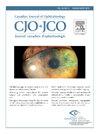Stratified choroidal vascular structure in treatment-naïve diabetic retinopathy
IF 3.3
4区 医学
Q1 OPHTHALMOLOGY
Canadian journal of ophthalmology. Journal canadien d'ophtalmologie
Pub Date : 2025-02-01
DOI:10.1016/j.jcjo.2024.05.015
引用次数: 0
Abstract
Objective
To analyze the anatomical choroidal vascular layers in topical treatment-naïve diabetic retinopathy (DR) eyes.
Design
A retrospective, clinical case-control study.
Methods
A total of 328 eyes from 228 patients with treatment-naive DR and 192 eyes matched for axial length from 174 healthy controls were enrolled in the study. Choroidal structure was quantitatively analyzed using enhanced depth imaging optical coherence tomography (EDI-OCT). Each choroidal vascular layer was divided into the choriocapillaris, Sattler's layer, and Haller's layer, and then the choroidal area (CA), luminal area (LA), stromal area (SA), and central choroidal thickness (CCT) were calculated using binarization techniques. The ratio of LA to CA was defined as the L/C ratio.
Results
In the choriocapillaris, CA was significantly lower in the mild/moderate non-proliferative DR (mNPDR) group than in the control group, and SA was significantly higher in all DR groups (each P < 0.01). The L/C ratio was significantly lower in all DR groups than controls (P < 0.01). In Sattler's layer, CA, LA, and SA were significantly higher in the severe NPDR (sNPDR) and PDR groups than in the control group (P < 0.01). In Haller's layer, the L/C ratio was significantly high among the PDR groups (P < 0.05).
Conclusions
The choroidal parameters of DR patients by the binarization method were associated with the stage of DR, in which the choriocapillaris lumen decreased in all the DR stages. The expansion of CA seen in more advanced DR eyes mainly resulted from changes in the Sattler's and Haller's layers.
Objectif
Analyser l'anatomie des couches vasculaires choroïdiennes dans des yeux atteints de rétinopathie diabétique (RD) qui n'ont jamais reçu de collyre.
Nature
Étude clinique rétrospective avec cas témoins.
Méthodes
Au total, 328 yeux de 228 patients dont la RD n'avait jamais été traitée et 192 yeux appariés pour la longueur axiale provenant de 174 sujets témoins en bonne santé ont été admis à notre étude. On a eu recours à la tomographie par cohérence optique à l'imagerie à profondeur améliorée (EDI-OCT, pour enhanced-depth imaging optical coherence tomography) pour réaliser une analyse quantitative de la structure de la choroïde. Chaque couche vasculaire de la choroïde a été divisée en 3 (choriocapillaire, couche de Sattler et couche de Haller). Par la suite, 3 aires (aire choroïdienne [AC], aire luminale [AL] et aire stromale [AS]) et l’épaisseur choroïdienne centrale (ECC) ont été calculées grâce à des techniques de binarisation. Le rapport entre l'AL et l'AC se définissait comme le rapport L/C.
Résultats
Dans la choriocapillaire, l'AC était significativement moindre en présence de RD non proliférante (RDNP) légère/modérée, comparativement aux mesures obtenues dans le groupe témoin. L'AS était significativement plus grande dans tous les groupes de RD (p < 0,01 pour l'ensemble des mesures). Le rapport L/C était significativement moindre dans tous les groupes de RD, comparativement au groupe témoin (p < 0,01). L'AC, l'AL et l'AS de la couche de Sattler étaient significativement plus grandes dans les groupes de RDNP grave et de RD proliférante, comparativement au groupe témoin (p < 0,01). Le rapport L/C dans la couche de Haller était significativement plus élevé dans les groupes de RD proliférante (p < 0,05).
Conclusions
Les paramètres choroïdiens calculés par binarisation chez des patients présentant une RD étaient associés au stade de la RD, le lumen de la choriocapillaire étant diminué à tous les stades de la RD. L'expansion de l'AC observée dans les cas plus avancés de RD tient surtout à des altérations des couches de Sattler et de Haller.
治疗前糖尿病视网膜病变的分层脉络膜血管结构。
目的:分析局部治疗无效的糖尿病视网膜病变(DR)眼的脉络膜血管层:分析局部治疗无效的糖尿病视网膜病变(DR)眼脉络膜血管层的解剖结构:方法:回顾性临床病例对照研究:方法:该研究共纳入了 228 名未接受过治疗的 DR 患者的 328 只眼睛和 174 名健康对照者的 192 只轴向长度匹配的眼睛。使用增强型深度成像光学相干断层扫描(EDI-OCT)对脉络膜结构进行定量分析。每个脉络膜血管层被分为脉络膜瓣、Sattler层和Haller层,然后使用二值化技术计算脉络膜面积(CA)、管腔面积(LA)、基质面积(SA)和脉络膜中心厚度(CCT)。LA 与 CA 的比值被定义为 L/C 比值:在脉络膜瓣中,轻度/中度非增殖性DR(mNPDR)组的CA明显低于对照组,而所有DR组的SA都明显高于对照组(P均<0.01)。所有 DR 组的 L/C 比值都明显低于对照组(P < 0.01)。在 Sattler 层,重度 NPDR(sNPDR)组和 PDR 组的 CA、LA 和 SA 明显高于对照组(P<0.01)。在霍勒层,PDR 组的 L/C 比值明显偏高(P < 0.05):二值化方法得出的DR患者脉络膜参数与DR的分期有关,其中绒毛膜管腔在所有DR分期中都有所减少。DR晚期眼球中出现的CA扩张主要是由于Sattler层和Haller层发生了变化。
本文章由计算机程序翻译,如有差异,请以英文原文为准。
求助全文
约1分钟内获得全文
求助全文
来源期刊
CiteScore
3.20
自引率
4.80%
发文量
223
审稿时长
38 days
期刊介绍:
Official journal of the Canadian Ophthalmological Society.
The Canadian Journal of Ophthalmology (CJO) is the official journal of the Canadian Ophthalmological Society and is committed to timely publication of original, peer-reviewed ophthalmology and vision science articles.

 求助内容:
求助内容: 应助结果提醒方式:
应助结果提醒方式:


